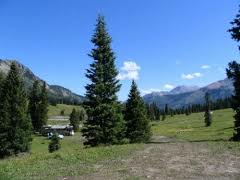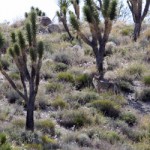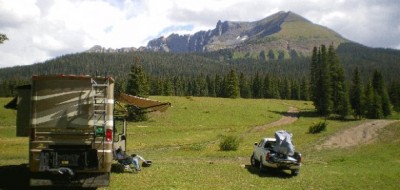By Bob Difley
 Beginning a few years ago the Forest Service began developing restrictions for users of the forests, including hunters, users of off-road vehicles, and campers. The new plan was titled The Travel Management Plan (TMP) and would be undertaken by the management of each individual forest to define their forest service roads that were authorized for motor vehicle use.
Beginning a few years ago the Forest Service began developing restrictions for users of the forests, including hunters, users of off-road vehicles, and campers. The new plan was titled The Travel Management Plan (TMP) and would be undertaken by the management of each individual forest to define their forest service roads that were authorized for motor vehicle use.
Theoretically, authorized roads would consist of those built by the forest service to approved standards, such as suitable for log trucks, cattle trucks bringing in cattle for grazing (on leases paid for by ranchers but still open for recreation), and fire fighting equipment. These roads, ideally, would also be suitable for large RVs as well.
Roads not authorized for motor vehicle use would include those established by users, such as hunters in 4WD trucks accessing hunting grounds or for hauling out their kills, trails created by off-road vehicles, and forest service roads that had been abandoned and not maintained. Most of these would not be suitable for RVs, except for truck campers mounted on 4WD trucks.
Campers/boondockers would only be allowed to park within one vehicle length of the road unless in an authorized “dispersed camping area” as defined by the forest service. The penalty for driving on an unauthorized road or parking in an unauthorized area could result in a $5,000 fine or six months in jail.
But–until we actually see this TMP implemented–which will begin to take place as the individual forests complete their plans–there is uncertainty as to how it will affect boondockers. For instance, it seems the individual forest supervisor has considerable discretion as to what–or how many–areas will be authorized as dispersed camping areas. Will they only be areas that can accommodate several rigs and eliminating from the list individual sites–which may be among your favorites? Will some access roads be eliminated because the supervisor, with a tight budget, sees a way to stop having to maintain a certain number of roads–and therefore not adding them to the authorized list– to save money?
The forest service maintains that they are not attempting to reduce those lands open for recreation, only to stop use of illegal roads and to stop carving out of new roads by off-roaders. The authorized and unauthorized roads will be shown on forest maps (called Motorized Vehicle Use Maps [MVUMs]), as will dispersed camping areas, and available on the individual forest’s website and at ranger stations. It would be advisable the next time you travel to a national forest to obtain these authorized maps and see whether they intend to eliminate your favorite boondocking areas.
The former rule stated that you could camp anywhere on forest service lands unless specifically prohibited by signs, fences, or gates. This will no longer apply. From now on–once the TMPs are finalized–you will be able to camp only where the TMP and MVUMs say you can–and illegal roads and camping areas will NOT be marked with signs or gates. Get a map to be sure your campsite is authorized.
So if you find a favorite boondocking campsite that is not on the list, talk to the rangers. It may be possible to still get it on the authorized list providing it is on a legal road. But time is flying by. Most of the TMPs are scheduled to be ready by the Fall of 2011.
Check out my website for more RVing tips, destinations, and for my ebooks: BOONDOCKING: Finding the Perfect Campsite on America’s Public Lands, Snowbird Guide to Boondocking in the Southwestern Deserts, and 111 Ways to Get the Biggest Bang out of your RV Lifestyle Dollar.



colon cleanse
Very good article, thank you for sharing. your sharing information is very useful for me, thank you!
colon cleanser
Nice! I have been looking for exactly this , thanks for posting
Natural colon cleanse
Blogs generally need lots of good, interesting and fresh content. I think that the best way to accomplish this is through a mixture of content curation and content creation. Ever since the latest Google updates, sites that use good curation strategies have managed to rise to the top. If you want to take a look at a good curation tool then check this out…
privatlån direkt
Obviously I like your web-site, but you have to check the spelling on several of your posts. A number of them are rife with spelling issues and I find it very troublesome to tell you. Nevertheless I will definitely come again again!
hgh supplements
nice post, i like so much, it’s the best information for me..
shoes
The shoes is interesting that this jeseys list were the epidemic strong, stylish displacement of the brand, the luxury man’s shoes that this organization of the economic situation, and with a strong spread of the woman’s shoes, Men’s Athletic Shoes clothing is relatively high.For Women’s Sandals with different designs and super excellent,The dress shoes especially easy collocation.
Mike n Teri
David Pusey is right on the mark. “There are RV’er’s that take care of the Forest Service Lands provided, but on the other side there are others that try to make there own roads and trails. The primary rule of each RV’er is not to leave anything on FS lands. Not trash,cans, dump sights,trees cut down, and never re-mold the land to your needs. We have seen several FS Lands that have been destroyed be people. Carved out banks to fit there rigs in and level the ground. Over the years the land has washed out and the roads that the FS made covered with dirt from the wash out.”
I maintained a trail section for 20 years, and saw first hand the damage done.
The author, Bob Difley, is also right on about saving your favorite place. Regrettably, the Forest Service has had their budget in jeopardy by all the resources they are required to fill; and bargain priced sales prices for lumber-trees they are required to meet.
Geoffrey Pruett
The real reason behind this is the extreme bad manners exibited by a very small percentage of the “entitled” generation. This small number enabled by the silence of many onlookers have slowly trashed many of our freedoms both in the cities and the wilderness. Remember when the school grounds were open for a ball game on weekends? Remember when school rooms were open for after hours classes and meetings? Remember when parks and play grounds did not have to post what is and is not allowed? This is the price of silence by many of us as trashing took place. If the quiet majority with manners remain silent, this is the future.
hoppe
This is just the continuation of the ‘Privatization’ of our Public Lands. They’ve been lobbying for more controls/privation for sometime.
DAVID PUSEY
My wife and I Travel a limited time during the year,but are going to start full time next April. When we travel we use TT membership and as for boondocking we have only stayed in rest areas. There are RV’s that take care of the Forest Service Lands provided, but on the other side there are others that try to make there own roads and trails. The primary rule of each RV”er is not to leave anything on FS lands. Not trash,cans, dump sights,trees cut down, and never re-mold the land to your needs. We have seen several FS Lands that have been destroyed be people. Carved out banks to fit there rigs in and level the ground. Over the years the land has washed out and the roads that the FS made covered with dirt from the wash out. Park beside the roads and don’t go on the trails to camp. REMEMBER <<<>>>
Grey Deacon
Membership camping more desirable at $5/day 365 days per year…That would be $1,825 a year total cost of camping in Membership campgrounds? I have been on the road now for over 10 years and have never found a $5 campground that is privately owned and operated. The campgrounds I have stayed in are much more expensive and they are filled with city folks; drinking, yelling, carrying on and parked cheek to butt. There has never been anything pleasant about the experience. I am in a Sprinter based B+++ and pull a small 4×4 with bikes. We too travel about 50 to 100 miles twice a month. Based on our experience there are not membership campgrounds every 50 miles in the west. We do go to ground about once every ten days for laundry, showers and shopping (catch a movie or local entertainment). So if you wish to share these supper cheap private membership campgrounds with two old geezers drop me an email [email protected]. Fred B. I think I see some smoke signals over your rig.
GDeacon
Tr Traveler
I never enjoyed going any where when I was not wanted.
Fred Brandeberry
Hi Guys & Gals:
We found membership camping more desirable. 13 years ago I listed 13 membership chain campgrounds on our laptop. Similar to streets & Trips mapping program.
We schedule 2 years ahead of time, mostly to cover major holidays, we can cancel any reservation at any time we choose.
In 2006 we spent $600 camping 365 nights west of the continental divide. $900 in $2007, and $5 a night in 2008/9.
Yes we like to visit many wonderful forests & National Parks with the Jeep we tow behind the motor home.
To keep fuel costs at a minimum we travel 50-150 miles twice a month.
Happy Camping,
Fred b.
Barry N. Schmidt
What’s interesting is that it is OUR land. Our ever-expanding government bureaucrats must keep implementing endless new rules and regulations to prove to taxpayers that their bureaucracies are still viable.